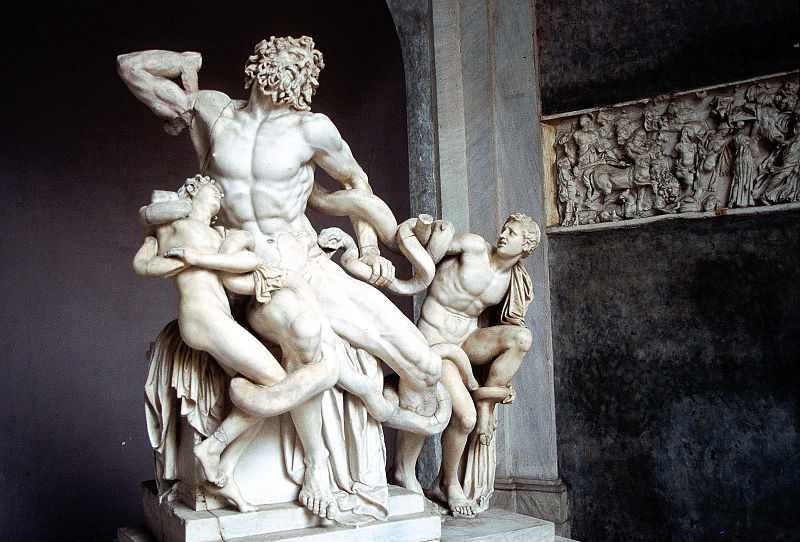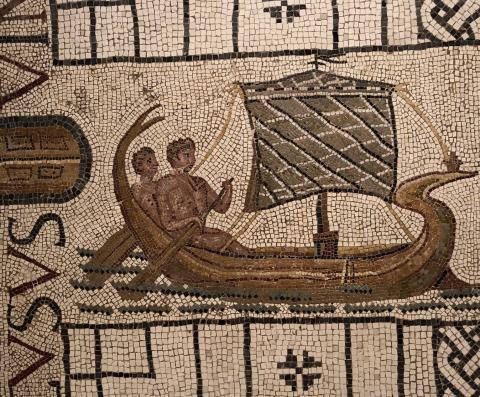Kathryn Topper
August 1, 2019
'Addressing the Divide' is a new series of columns that looks at the ways in which the modern field of Classics was constructed and then explores ways to identify, modify, or simply abolish the lines between fields in order to embrace broader ideas of what Classics was, is, and could be. This month, Kathryn Topper addresses the divisions between Art History and Classics.
For specialists in Greek and Roman art, professional life is an endless navigation of disciplinary divides. Often it seems like we belong to a disciplinary no man’s land – too archaeological for other art historians, too art historical for field archaeologists, and too visual for text-oriented Classicists whose training has predisposed them to doubt the intellectual seriousness of scholars who study something as seemingly straightforward as pictures.
The uneasy position of ancient art historians relative to the allied disciplines arises from historical factors, but it’s also a consequence of the nature of our material. When you work in a field in which reconstruction and interpretation almost invariably go hand in hand, you tend to need all the tools in your own toolbox, and in the neighbors’ toolboxes, too. As a result, historians of ancient art spend a lot of time working in disciplines dominated by colleagues whose priorities and training are very different from our own.
Although the divide between the textual and art historical sides of Classics will be the main focus of this blog, I want to start by discussing a different divide, the one between the fields of Art History and Archaeology. Whether the history of Greek and Roman art properly belongs to Classical Archaeology is a fraught question – and, if I’m being honest, my own answer usually depends on the specifics of the conversation. Certainly, Classical art historians and archaeologists share many of the same experiences in Classics, such as a responsibility for understanding Greek and Latin in a way that is not reciprocated by our textual colleagues – and we are both likely to find ourselves “specializing” in two cultures and a millennium and a half worth of material in departments that permit our colleagues a much narrower focus. We also teach a lot of the same material, at least at the undergraduate level, where the structure of many departments doesn’t allow us greater specialization. In conversations about our place(s) within the larger field of Classics, then, I usually find myself on the same page as field-oriented archaeologists.
In conversations about our research, however, we tend to diverge, not only in our interests but in our perceptions of our field(s). The discussion of Winckelmann in this series’ most recent blog, for instance, would read very differently if it had been written by an art historian; far from stagnating in his grip, historians of ancient (and later) art have done much to face Winckelmann’s legacy and its implications for our work head-on. Art historians and archaeologists also frequently – and probably inevitably – diverge in our ideas about how Classical archaeologists should be trained. While there is usually agreement about the outsize role of the ancient languages in our training (something I have mixed feelings about myself), there’s little agreement on what should be added in their place: GIS training? Art historical method and theory? More work in anthropology? Better (or any) training in how to study biological remains? More study of the cultures with which the Greeks and Romans came into contact? Ask five different Classical archaeologists, and you’ll get at least five different answers. This diversity of approaches can be exciting, but it is also unwieldy.
I begin with these comments about the relationship between art history and archaeology because I don’t think it’s possible to understand the divide between the fields of Art History and Classics without some sense of where Classical Archaeology fits into all of this. In the rest of this post, I’d like to address three common misconceptions about the study of ancient art and its relationship to Classics, although some of these apply to Classical Archaeology, too. I end with a few thoughts about how to move forward.
Misconception 1: The study of Classical art (and archaeology) is smaller and less complex than the study of Classical literature.
Most Classics departments – especially at research universities – are structured according to this assumption. If you are a literature scholar who doesn’t see why this is the problem, I’d ask you to imagine the following: you are the only person who studies literature in a Classics department of ten. Your colleagues include a specialist in Roman sculpture, one in Greek painting, one in Roman painting, one in Greek sculpture, one in Hellenistic architecture, one in Roman mosaics, one in Greek and Roman gems, one in Etruscan art, and so on. They each routinely teach courses in their specialties, often at multiple levels. By contrast, you are responsible for the entire curriculum in Greek and Latin (if you’re lucky, there are two literature scholars, one for each language), as well as for covering the art historians’ courses when they are on leave or otherwise unable to teach them. If you’re lucky enough to have a Classical languages major in your department, it requires students to take six semesters of Greek and Latin (total), four semesters of Classical art history, and maybe one Comparative Literature course outside the department.
This is a ridiculous scenario, and it’s only slightly less ridiculous if we replace some of the art historians with archaeologists. Yet this – mutatis mutandis – is precisely what specialists in ancient art and archaeology regularly face when we are hired in Classics departments. There are real problems with this set-up beyond the intellectual isolation it can engender. For one thing, it places a much heavier teaching burden on the token art historian or archaeologist – even if their course load is the same as their colleagues’ – because of the time required to keep current with so many fields and skills. More insidiously, departments with such a structure almost invariably reproduce themselves, creating new generations of Classical scholars with a lot of knowledge about the texts and very little about other parts of the ancient world.
Misconception 2: Visual material is easier to understand and less intellectually serious than texts. As Ernst Robert Curtius famously put it, “There is nothing [in images] that is unintelligible. To understand Pindar’s poems, we have to rack our brains. That does not apply to the Parthenon frieze.” [1]
This is both a cause and a consequence of the first misconception, because a field that understands images to be simpler than texts will naturally devote less attention to them and will thus perpetuate the same misconception in its students. All the same, I never stop being amazed at the glibness with which I hear my discipline routinely dismissed. Cracks about “pretty pictures” – as if the visual material is simply there to entertain or to keep one’s audiences awake – are bad enough, but I have also heard (not, I hasten to add, at my current institution) of bright students being advised not to major in Classical art and archaeology “because that’s for people who don’t know Latin.” I’ve also heard the entire study of ancient art dismissed as “bullshit.” Most dispiriting, though, is seeing the art historical wheel reinvented when well-meaning Classicists “discover” the material we work on but see no need to consult our scholarship on it.
I could go on about this issue at length, but for the purpose of this blog, I have just two observations. The first, which will surprise no one who has heard of the Dunning-Kruger effect, is that the tendency to dismiss art history tends to be inversely proportional to how much one has studied it. The second observation is that these dismissals are never ideologically innocent.
In her 1995 Presidential Address to what was then the American Philological Association, the archaeologist Emily Vermeule touched on the ideological underpinnings of Classicists’ tendency to value the study of language and literature over field archaeology. She suggested that the divide reached back to the Middle Ages:
…the low esteem felt by classical philologists toward field archaeologists was a remnant of the mediaeval tradition by which those who dealt in Dirt were felt to practice the mechanical arts, while those who dealt in the Word belonged in the liberal arts. The liberal arts are still more highly prized in academic places than the mechanical arts; the Word is still generally felt to be more powerful than, as well as cleaner than, the Dirt.
Vermeule was not talking about art history, but her observation that the academy tends to attach specific values to categories like “words” and “dirt” and then arrange those categories into hierarchies is no less applicable when the category in question is “images.” This is something W.J.T. Mitchell explores brilliantly in an essay on the “Politics of Genre” in G.E. Lessing’s Laocoön, which was one of the seminal texts about the relationship between images and words.

As Vermeule does for the word/dirt binary, Mitchell shows that when we construct a binary such as word/image, we are never just talking about words and images. These categories come with a host of values attached – for Lessing, time/space, mind/body, and masculine/feminine, to name a few. While this blog is not the place to unpack the values that underlie Classics’ tendency to privilege words over images (much less the field archaeology/art history dichotomy), it has never seemed entirely accidental to me that the half of the binary that is coded “feminine” is the one that Classicists are so comfortable writing off.
Misconception 3: Ancient images exist to illustrate texts or to help us reconstruct ancient life.
Few people would probably admit to this assumption when it is stated in these terms, but a lot of people – archaeologists as well as literary scholars – hold some version of it. Most Classicists, myself included, have a powerful desire to know what the ancient world looked like, and Classical art often looks sufficiently naturalistic to us that we forget that seemingly basic features such as skin color, eye shape, and clothing (or the absence thereof) are matters of convention. There is really no level on which an ancient art historian’s job does not require interpretation; even figuring out what one is looking at can require a lot of work.
.jpg)
Take, for example, this image on a fifth-century rhyton (a type of drinking vessel) from Athens. Scholars of ancient art have struggled to understand the foreign-looking cap on the musician, but there isn’t even agreement about the basic level on which the cap is to be understood. Is it an actual piece of costume worn at symposia in fifth-century Athens? Is it a metaphor for a particular type of behavior – the visual equivalent of the statement that someone is drinking “like a Scythian”? Or is it an imaginary piece of costume associated with long ago or faraway places? Each of these suggestions has its proponents, and each has its merits.
What is clear is that ancient artists were not out to make life easier for us – to fill in the blanks left by fragmentary texts and incomplete archaeological remains. They had their own agendas, which take effort to uncover, and which are only sometimes what the texts or archaeological sites might lead us to expect. The visual evidence can tell us a great deal about the ancient world, but it is not (pace Curtius) there to illustrate the ancient world for us any more than Pindar’s odes exist to provide a clear picture of the Panhellenic games.
Coda: Where do we go from here?
I’ve noted the disdain with which art history is sometimes treated within Classics – yet for every Classicist who dismisses art history as unimportant or intellectually substandard, I hear another say that they wish it had been a bigger part of their graduate training. This is especially true of younger generations of Classicists, something that makes me hopeful. Ultimately, the solution to both the ignorant dismissals and the desire for better training is probably the same: Classics departments should be training our graduate students to know enough about Greek and Roman art to understand the limits of their knowledge, but we should also be equipping them with the tools to ask informed and intelligent questions about the visual material.
Precisely what this training would look like will probably vary from program to program, but a single proseminar session plus one course is unlikely to cut it. More robust art historical training would certainly require a shift in resources for many departments, but more balance can only be a good thing. Classics cannot be an intellectually healthy field as long as it refuses to take non-textual materials – including visual material – as seriously as it takes the texts.
[1] Quoted in D. Wuttke, Kosmopolis der Wissenschaft: E. R. Curtius und das Warburg Institute (Baden-Baden, 1989), Appendix XV, translated in Jeffrey M. Hurwit, The Athenian Acropolis: History, Mythology, and Archaeology from the Neolithic Era to the Present (Cambridge, 1998), p. 222.
Header Image: Late antique mosaic likely depicting Theseus sailing away from the Labyrinth (Utica, Tunisia, 3rd C CE, now at the University of Pennsylvania Museum of Archaeology and Anthropology. Image by Sarah E. Bond).
Authors


